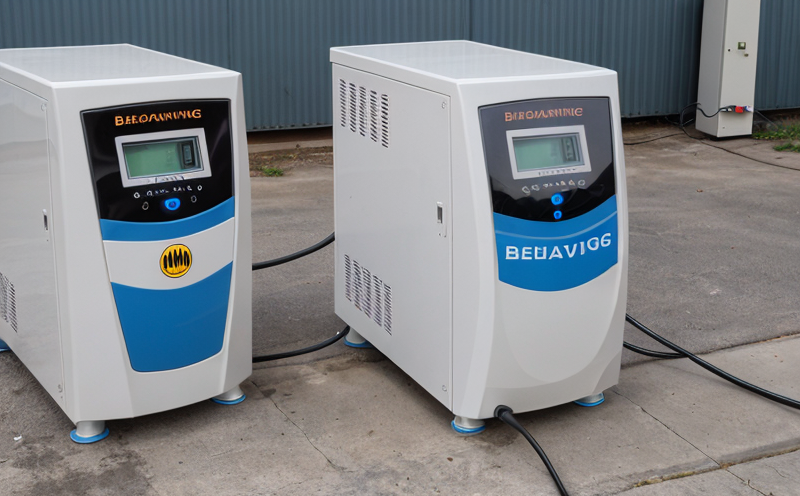ISO 18243 Charging and Discharging Testing of Lithium-Ion Batteries for Light EVs
The ISO 18243 standard is pivotal in ensuring that lithium-ion batteries used in light electric vehicles (EVs) meet stringent performance, safety, and durability requirements. This testing protocol evaluates the charging and discharging behavior of these batteries under controlled conditions to assess their efficiency, capacity retention, and overall reliability over time.
Lithium-ion batteries are critical components for the success of modern EVs, influencing everything from range anxiety to environmental sustainability. The ISO 18243 standard provides a comprehensive framework that helps manufacturers ensure consistent battery performance across different vehicles and models. By conducting this test, companies can identify potential issues early in the development process, thereby improving product quality and reducing post-launch recalls.
The testing protocol involves simulating real-world charging and discharging scenarios to closely mimic actual usage conditions. This includes setting specific charge rates, discharge depths, and temperature profiles that are representative of typical driving patterns. The standard also emphasizes the importance of maintaining precise control over these parameters throughout the test cycle to ensure accurate results.
The results from this testing are crucial for several reasons. Firstly, they provide a standardized method for comparing different battery technologies and designs. This is particularly important in an industry where new innovations are constantly being introduced. Secondly, the data generated can be used to optimize battery management systems (BMS) within vehicles, enhancing both performance and longevity. Lastly, compliance with ISO 18243 helps ensure that products meet regulatory requirements, which is essential for market entry and consumer trust.
The test process typically begins with a detailed pre-test setup where the batteries are preconditioned to specified temperatures and humidity levels. This ensures that all units start from a consistent state before undergoing the charging and discharging cycles. During these cycles, various metrics such as voltage, current, power, and internal resistance are continuously monitored and recorded.
After completing the test cycle, the batteries undergo post-test evaluation to assess their performance metrics against specified acceptance criteria. These criteria may include maximum allowed internal resistance values, minimum capacity retention percentages, and acceptable variations in state of charge (SoC) after each discharge and recharge step. Any battery that fails to meet these criteria is deemed non-compliant with ISO 18243 standards.
The importance of this testing cannot be overstated, especially as electric vehicles become more prevalent on roads worldwide. By adhering to the stringent requirements set forth by ISO 18243, manufacturers can build confidence in their products while also contributing to the overall advancement of sustainable transportation solutions.
Why It Matters
The results from ISO 18243 charging and discharging testing are crucial for several reasons. Firstly, they provide a standardized method for comparing different battery technologies and designs. This is particularly important in an industry where new innovations are constantly being introduced. Secondly, the data generated can be used to optimize battery management systems (BMS) within vehicles, enhancing both performance and longevity.
Compliance with ISO 18243 helps ensure that products meet regulatory requirements, which is essential for market entry and consumer trust. Additionally, by adhering to these standards, manufacturers can build confidence in their products while also contributing to the overall advancement of sustainable transportation solutions.
- Ensures Consistency: By following ISO 18243, companies ensure that all batteries undergo the same rigorous testing procedures, leading to consistent performance across different models and vehicles.
- Promotes Innovation: The test results provide valuable insights for improving battery technologies and designs. This fosters innovation within the industry and drives continuous improvement in product quality.
In summary, ISO 18243 charging and discharging testing is essential for maintaining high standards of performance, safety, and reliability in lithium-ion batteries used in light electric vehicles.
Eurolab Advantages
EuroLab offers unparalleled expertise and state-of-the-art facilities to conduct ISO 18243 charging and discharging testing for lithium-ion batteries. Our team of experienced professionals ensures that every test adheres strictly to international standards, providing clients with accurate, reliable results.
- Accreditation: EuroLab is fully accredited by leading accreditation bodies, ensuring the highest level of quality assurance.
- Advanced Equipment: We utilize cutting-edge equipment and software that provide precise measurements and data collection during testing.
Beyond technical proficiency, we prioritize customer satisfaction. Our dedicated team offers personalized support throughout the testing process, from initial consultation to final report generation. This ensures that our clients receive not just test results but actionable insights that drive informed decision-making within their organizations.
With EuroLab's comprehensive approach, you can trust us to deliver top-tier service in ISO 18243 charging and discharging testing for lithium-ion batteries used in light electric vehicles. Let us help you meet your quality assurance goals with confidence and precision.
Why Choose This Test
- Comprehensive Evaluation: ISO 18243 provides a holistic assessment of battery performance, covering all critical aspects from initial charge to final discharge.
- International Recognition: Compliance with this standard is widely recognized and accepted across the global automotive industry.
This testing ensures that lithium-ion batteries used in light electric vehicles meet stringent performance, safety, and durability requirements. By conducting ISO 18243 charging and discharging tests, manufacturers can identify potential issues early in the development process, thereby improving product quality and reducing post-launch recalls.
The test results are also crucial for comparing different battery technologies and designs, optimizing battery management systems within vehicles, and ensuring compliance with regulatory requirements. This not only enhances consumer trust but also contributes to the overall advancement of sustainable transportation solutions.





